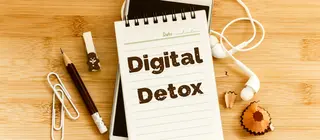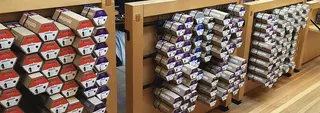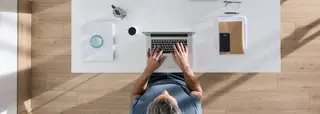
Ever heard of a “digital detox”? It consists of going without your devices for a prolonged period of time; possibly one day, a weekend or maybe even a week.
Screen fatigue is real. While digital tools have helped us to achieve more than we’ve ever imagined, we also realize it’s time for a little technological balance with the help of some non-technological tools.
Paper is a powerful tool for fueling productivity and creative thinking. Consider using analog tools with some digital techniques, and use both during the course of your day, whether working remoting or in an office setting, and watch your productivity soar.
The Power of Planning
So many of us begin our day with our head down scrolling through our emails — before you know it we're experiencing brain fog without having accomplished anything.
Instead of immediately opening your emails, begin your work day by using a notebook or a business journal to prioritize the top three goals or projects you need to start, prep or finish that day. Choose a notebook or journal that’s fun, fancy, or what you imagine a CEO's got on their desk.
Did you know that the physical act of writing boosts learning and goal achievement? Writing stimulates your RAS (reticular activating system), which are a bunch of cells at the base of our brain. When you write something down you activate and deepen your focus. So grab your business journal and start tracking your daily progress.
Time Block
Once you've planned your three most important goals for the day, plug them into your calendar. Learning to time block your goals is one way to make sure there’s time in the day for more than just meetings. Without the discipline of time blocking we can fall down the rabbit hole of answering emails for hours and lose the necessary momentum for our projects.
Pick the time of day that you’re the most productive and commit that time to your goals and projects. Prioritize your needs and block your time.
Turn Off the Notifications
Our brains are constantly seeking pleasure and love to be surprised. Our phones ping, ring and ding with every new email, text and tweet, putting us in a dopamine seeking loop like Pavlov’s dog.
We have a stimulus or cue, and continue to seek a reward. How can we get anything done if we’re constantly checking our devices for something new and exciting? You can’t. And, this leads to a bigger problem: it destroys your focus, gives you brain fog and spikes your cortisol. Shut off the notifications and watch your productivity soar.
Tech Free Meetings
Leave your device at the door or at your desk at your next meeting, and instead, bring your favorite colored pen or pencil, paper or business journal.
Ever heard of the smartphone effect? The mere presence of a phone on a table is distracting. Research tells us that our conversations have less depth, which means we’re not developing trust.
Meetings are a valuable source of face time, and devices have us looking down and avoiding eye contact. It’s well known that higher levels of eye contact increases likeability, trust and competence. At your next meeting ditch your device and politely ask that your teammates do the same.
Device-Free Zones
If we're only spending time on screens during the day we forget how to imagine, create and collaborate. We're social by nature, but instead of asking a human being we consult Google, Siri or Alexa. Let's train our brains to search and seek the advice of coworkers.
Conversation develops trust, friendship and more sociability in the workplace. This in turn creates a healthier, happier and more productive workplace. When we spend time talking and collaborating with our coworkers, we’re bonding, building trust and boosting oxytocin.
In your personal office, create a device free zone-- this could be a few chairs and a table, or find a spot in a breakroom that you designate as device free, outfitted with colored paper, sketch pads and sharpies, and start to draw, doodle and sketch out ideas. Invite co-workers and let them know that doodling relieves stress, improves productivity and psychologist Jackie Andrade found that it also improves your listening. Why wouldn’t you make the time to doodle?!
Take Breaks and Drink Green… Visually
Our eyes need to rest from our devices. We get more headaches, blink less and are experiencing an increase in dry eyes. Here’s the good news: the Mayo Clinic has told us that nature nurtures and relaxes the brain, decreases cortisol (the stress hormone) and allows us to see other options when it comes to problem solving.
Have you ever taken a walk in the park and suddenly saw the answer to your biggest problem? Device-induced brain fog is real and it’s vital to clear it in order to have more saturated thinking.
Whether it’s a micro-break or a little longer, employees who take breaks every 90 minutes report a higher level of focus and productivity. Take a break every hour and a half and doodle, look at a plant on your desk or have a green screen saver. This gives your brain the opportunity to recharge for what you need to do next.
Set Parameters and Productivity Soars
You may have the Twitter feed on all day, but ask yourself why. What are you specifically looking for? What’s your intention?
If you want to know what’s trending, check the feed once in the morning and once in the afternoon. Doing research? Great. Decide if you need 15 minutes, 30 minutes or a bit longer and set a timer. Without setting parameters it’s too easy to fall down the rabbit hole and lose too much time and productivity.
Following the feed all day means you’re constantly trying to multitask. Since the human brain can’t actually multitask, what we’re doing is just quickly task-switching from one to the next and tiring out our brain — impairing our ability to problem solve, killing our creativity and lowering our IQs.
Whether you start with one of these ideas or four, work to incorporate more paper products into your day. You’ll feel less frazzled, more in control and calmer as the day begins to unfold exactly as you’ve written in your planner. There’s something magical about a brightly colored calendar, a not-so-digital datebook and paper printouts that let you express, ideate and create your next big breakthrough.

Holland Haiis is an expert on digital detox and human connection. She is a speaker, author and business consultant who has served Fortune 500 companies, as well as the insurance, hospitality and healthcare industries. Holland was recognized by Hay House as one of 100 Global Thought Leaders and is often called upon by CNN, ABC, NBC, CBS, and many others for her expertise. For more information on Holland or to book her to speak at your organization visit her website at HollandHaiis.com



